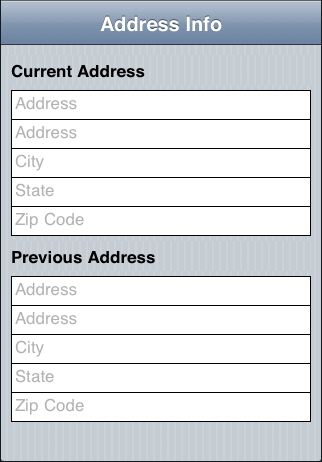Say you want each customer to accept your Terms of Service, or some other legalese, before they can use your iPhone application.
Display the screen upon startup
The standard AppDelegate code generated by Xcode creates and displays your first application screen. Here’s a way that you can use the hidden property of UIView to display your new screen first without disrupting the flow of the rest of the application.
// Create window
self.window = [[[UIWindow alloc] initWithFrame:[[UIScreen mainScreen] bounds]] autorelease];
[window setBackgroundColor:[UIColor whiteColor]];
// Set up main view navigation controller
MainMenuViewController *navController = [[MainMenuViewController alloc] init];
// Create a navigation controller using the new controller
navigationController = [[UINavigationController alloc] initWithRootViewController:navController];
navigationController.navigationBarStyle = UIBarStyleDefault;
[navController release];
// Create Terms of Service screen
tosController = [[TermsOfServiceViewController alloc] init];
[window addSubview:[tosController view]];
navigationController.view.hidden = YES;
// Add the navigation controller's view to the window
[window addSubview:[navigationController view]];
[window makeKeyAndVisible];
Most of this is boilerplate code, more or less generated by Xcode. What’s new starts at line 14. Instantiate the new TermsOfServiceViewController and add it to the view. Standard stuff. The important line is #17, which hides the navigationController.
Dismiss the new screen
Now that the Terms of Service screen is displayed and the Main Menu is hidden we need a way to dismiss the ToS screen and return to the normal application flow.
In your AppDelegate class create a new method:
- (void)termsOfServiceAccepted
{
tosController.view.hidden = YES;
navigationController.view.hidden = NO;
}
In the TermsOfServiceController you would have a button that the user has to tap:
UIButton *acceptButton = [[UIButton buttonWithType:UIButtonTypeRoundedRect] retain];
acceptButton.frame = CGRectMake(kLeftMargin,
applicationFrame.size.height - kBottomMargin - kButtonHeight,
applicationFrame.size.width - kLeftMargin - kRightMargin,
kButtonHeight);
[acceptButton setTitle:NSLocalizedString(@"ButtonAcceptTermsOfService", @"") forStates:UIControlStateNormal];
[acceptButton addTarget:self action:@selector(termsOfServiceAccepted:) forControlEvents:UIControlEventTouchUpInside];
[self.view addSubview:acceptButton];
When the button is tapped, the selector is called which in turn calls the above method in the AppDelegate.
- (void)termsOfServiceAccepted:(id)sender
{
id applicationDelegate = [[UIApplication sharedApplication] delegate];
[applicationDelegate termsOfServiceAccepted];
}
Only show the screen once
With this code the ToS screen is displayed every time the application is started. That will quickly get annoying. So let’s add some code to only show it once by using a boolean stored in NSUserDefaults.
NSUserDefaults *userDefaults = [NSUserDefaults standardUserDefaults];
if (![userDefaults boolForKey:TERMS_OF_USE_ACCEPTED]) {
tosController = [[TermsOfServiceViewController alloc] init];
[window addSubview:[tosController view]];
navigationController.view.hidden = YES;
}
And in the termsOfServiceAccepted method set the boolean in NSUserDefaults.
- (void)termsOfServiceAccepted
{
tosController.view.hidden = YES;
navigationController.view.hidden = NO;
// Store acceptance in UserDefaults
NSUserDefaults *userDefaults = [NSUserDefaults standardUserDefaults];
[userDefaults setBool:YES forKey:TERMS_OF_USE_ACCEPTED];
}
Now the ToS screen is only shown until the user taps the accept button. Your customers will be happy, as will your lawyers.
written by Nick
\\ tags: NSUserDefaults, UIApplication, UIView
